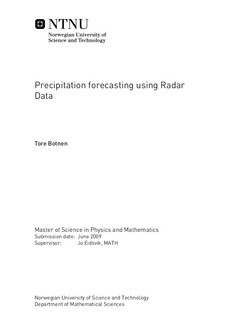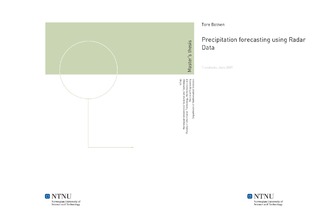| dc.description.abstract | The main task of this assignment is to filter out noise from a series of radar images and to carry out short term precipitation forecasts. It is important that the final routine is performed online, yielding new forecasts as radar images arrive with time. The data available is a time series arriving at a one hour ratio, from the Rissa radar located in Sør Trøndelag. Gaussian radial basis functions are introduced to create the precipitation field, whose movement is solely governed by its velocity field, called advection. By performing discretization forward in time, from the basis given by the differential advection equation, prior distributions can be obtained for both basis functions and advection. Assuming normal distributed radar errors, the basis functions and advection are conditioned on associating radar images, which in turn can be taken into the prior distributions, yielding new forecasts. A modification to the model, labeling the basis functions either active or inactive, enable the process of birth and death of new rain showers. The preferred filtering technique is a joint MCMC sampler, but we make some approximations, sampling from a single MCMC sampler, to successfully implement an online routine. The model yield good results on synthetic data. In the real data situation the filtered images are satisfying, and the forecast images are approximately predicting the forthcoming precipitation. The model removes statistical noise efficiently and obtain satisfying predictions. However, due to the approximation in the MCMC algorithm used, the variance is somewhat underestimated. With some further work with the MCMC update scheme, and given a higher frequency of incoming data, it is the authors belief that the model can be a very useful tool in short term precipitation forecasting. Using gauge data to estimate the radar errors, and merging online gauge data with incoming radar images using block-Kriging, will further improve the estimates. | nb_NO |

